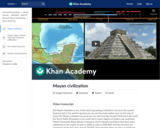
An overview of the Mayan civilization as well as the great city of Teotihuacan.
- Subject:
- History
- Material Type:
- Lesson
- Provider:
- Khan Academy
- Provider Set:
- Khan Academy
- Author:
- Sal Khan
- Date Added:
- 07/26/2021

An overview of the Mayan civilization as well as the great city of Teotihuacan.

In McCulloch v. Maryland, the U.S. Supreme Court ruled that Congress had the authority to charter a national bank based on the “necessary and proper” clause of the Constitution. In later years, this “implied power” enabled Congress to pass laws in many different areas. Access to this resource requires a free educator login.

The purpose of this lesson is to explain the two overarching modes of constitutional interpretation – strict and loose construction – and their use and application to particular Supreme Court cases. After an in-class investigation activity to explore the various methods of interpretation, students will be given the opportunity to demonstrate their command of these definitions and express their opinions of the merits and limitations of each method during a mock Supreme Court session where students will revisit the Court’s opinions in Brown v. Board of Education (school segregation) and DC v. Heller (Second Amendment).

What were the causes and effects of the Mexican-American War? In this video, Kim discusses how Manifest Destiny and the annexation of Texas brought on the war, as well as how the war affected US politics and the existing residents of the Mexican Cession.
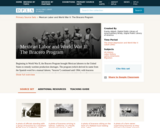
This collection uses primary sources to explore the Bracero Program. Digital Public Library of America Primary Source Sets are designed to help students develop their critical thinking skills and draw diverse material from libraries, archives, and museums across the United States. Each set includes an overview, ten to fifteen primary sources, links to related resources, and a teaching guide. These sets were created and reviewed by the teachers on the DPLA's Education Advisory Committee.
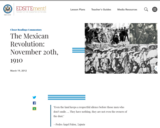
The Mexican Revolution, which began on November 20, 1910, and continued for a decade, is recognized as the first major political, social, and cultural revolution of the 20th century. In order to better understand this decade-long civil war, we offer an overview of the main players on the competing sides, primary source materials for point of view analysis, discussion of how the arts reflected the era, and links to Chronicling America, a free digital database of historic newspapers, that covers this period in great detail.
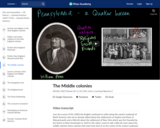
The Middle colonies consisted of Pennsylvania, New Jersey, New York, and Delaware. Located in the middle of the Atlantic seaboard, their economies combined the industry of the North with the agriculture of the South. They were unusual, however, for their degree of religious toleration and their wide range of ethnic diversity.
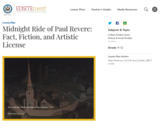
This lesson encourages close study of Wood's painting, American Revolution primary sources, and Longfellow's poem to understand the significance of this historical ride in America's struggle for freedom. By reading primary sources, students learn how Paul Revere and his Midnight Ride became an American story of patriotism.
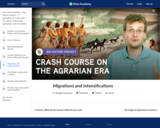
In which Hank and John Green teach you about humanity conquering the Earth. Or at least moving from Africa into the rest of the Earth. As human beings spread out across the world and populations grew, humanity reached a critical mass of innovators, and collective learning took off! All these innovations were great for lots of human endeavors, but none fared better than agriculture.

Travel through time in a rowboat to consider some of the "mini-thresholds" in the development of life on Earth. Created by Big History Project.
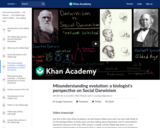
In the late nineteenth century, sociologists misused Darwin's theory of evolution to justify racism. KA's historian Kim and biologist Emily discuss how evolution really works and how sociologists in the Gilded Age misunderstood its application to human society.
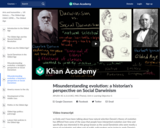
Does "survival of the fittest" apply to human culture? Kim and Emily continue their discussion of the theory of evolution and how Gilded Age sociologists mistakenly applied it to race and class.
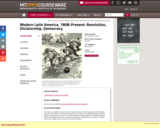
Selective survey of Latin American history from the wars of independence at the start of the nineteenth century to the present. Issues studied include: independence and its aftermath, slavery and its abolition, Latin America in the global economy, relations between Latin America and the US, dictatorships and democracies in the twentieth century, and revolution in Mexico, Cuba, and Central America.
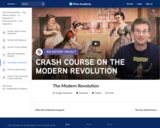
As civilizations grew larger, demand for resources grew along with it. This led people to spread out over larger territories in search of food, natural resources, and new ideas.
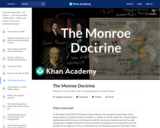
In 1820, James Monroe articulated the US foreign policy goal of ending European colonization in the Americas.
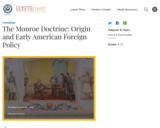
Monroe brought a vision of an expanded America to his presidency"”a vision that helped facilitate the formulation of what has become known as the Monroe Doctrine. In this unit, students will review the Monroe Doctrine against a background of United States foreign relations in the early years of the republic.

For more than two hundred years, the Capitol has been the place where representatives of the American people have debated how best to achieve the nation's ideals. This exhibit displays some of our most important documents, drawn primarily from the collections of the Library of Congress and the National Archives, to illustrate the role of Congress in defining and helping to realize national goals and aspirations.
Learn more in this virtual exhibit.

For more than two hundred years, the Capitol has been the place where representatives of the American people have debated how best to achieve the nationâ ideals. This exhibit displays some of our most important documents, drawn primarily from the collections of the Library of Congress and the National Archives, to illustrate the role of Congress in defining and helping to realize national goals and aspirations.
Learn more in this virtual exhibit.

The issue of slavery permeated debate in Congress from the founding of the country through the mid-nineteenth century. The failure to resolve differences between states on the issue of slavery led to the Civil War. To manage both the war effort and its consequences, Congress crafted new legislation that addressed a changing nation.
Learn more in this virtual exhibit.

Congress is the forum where elected representatives address issues facing the nation. These issues sometimes arise from conflicting ideas within the nation, or from the pressures of world events. By providing a place for debate and compromise, Congress has led the nation through challenging times.
Learn more in this virtual exhibit.